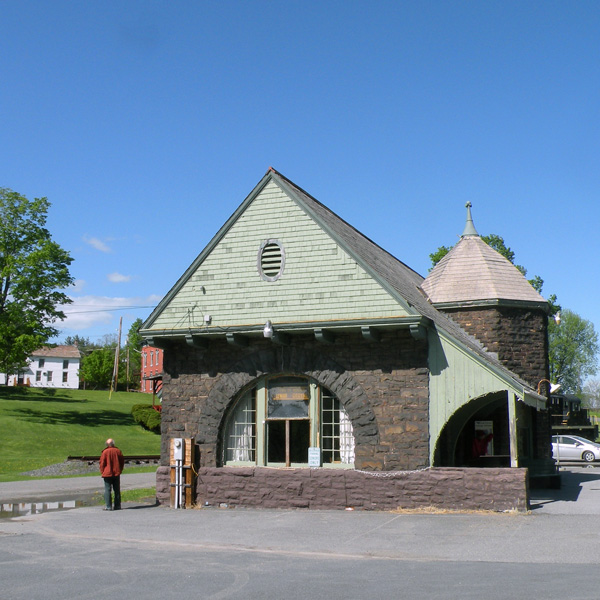Port Henry, NY (POH)
Built in 1888 for the Delaware and Hudson Railway, the picturesque Romanesque-style depot houses a small passenger waiting room and the Moriah Senior Citizens Center.

20 Park Place
Port Henry, NY 12974-1324
Annual Station Ridership (FY 2023): 172*
- Facility Ownership: D&H Railway Company, Inc.
- Parking Lot Ownership: D&H Railway Company, Inc.
- Platform Ownership: Canadian Pacific Railway Co.
- Track Ownership: Canadian Pacific Railway Co.
Jane Brophy
Regional Contact
governmentaffairsnyc@amtrak.com
For information about Amtrak fares and schedules, please visit Amtrak.com or call 1-800-USA-RAIL (1-800-872-7245).
The stone Romanesque Revival station at Port Henry was built in 1888 by George Sherman for the Delaware and Hudson Railway (D&H). The station building, which was entered into the National Register of Historic Places on June 1, 1995, houses the Moriah Senior Citizens Center as well as a passenger waiting room. A caretaker from the Senior Center opens and closes the station for travelers.
Sited on the western bank of Lake Champlain, the village of Port Henry is part of the Moriah Township of mountainous Essex County. Europeans first came to the region when Champlain and his companions arrived in 1609. The conflict between the French and English over this territory delayed settlement by those of European descent. The English King empowered colonial governors to issue land grants in 1763 and soldiers were granted these lands as compensation for their services in the French and Indian War.
This part of the Adirondack Mountains, both in Vermont and New York, is rich in both iron ore and lumber. While a mill was built there in 1766, the first permanent settlement came in 1785, when William McKenzie settled in what became Port Henry. The St. Regis and Oswegatchie tribes also lived in the area, and were noted as living at Moriah Corners as late as 1804. At first, the docks built at Port Henry shipped lumber from the heavily forested hills as early as 1820, where it was rafted north to Canada and when the Champlain Canal opened, to markets downstate.
Iron ore being plentiful in the area on both sides of the lake, nearly every landowner had a try at mining. The Cheever bed north of Port Henry began to be worked seriously in 1853, as well as a number of other smaller beds. The first Port Henry blast furnace was built in 1824, and it took in ore from nearby Witherbee and Mineville to ship out on the lake. By 1869 the Lake Champlain & Moriah Railroad was carrying ore to the port, and Port Henry shipped out 230,000 tons of ore in 1868 from the beds in Moriah Township.
The Witherbee-Sherman and Company mining company made its headquarters in Port Henry, where the Sherman family had prominence and built their waterfront complex, which is still used. The Iron Center Museum is housed in a former carriage house, ice house, and laboratory for testing iron ore. The main office, built in the grand French Second Empire style in 1875, now houses the Moriah town offices. The remains of the steel trestle, built in 1929 for loading ore, can be seen along the waterfront. However, all that remains of the huge Cedar Point Blast Furnace and Foundry, which produced 200 tons of iron per day in 1892, is the concrete block warehouse now used by the marina. Outdoor displays include a Lake Champlain and Moriah locomotive, ore car, and caboose.
Nearby Ironville, on Crown Point, claims to be the “birthplace of the electric age,” as it is the site of the first industrial application of electricity. Allen Penfield purchased large electromagnets from its inventor, Joseph Henry, for use at the ironworks in 1831, where it was used to separate crushed magnetite ore from its quartz matrix.
Service on the Adirondack is financed primarily through funds made available by the New York State Department of Transportation.
*Adirondack service resumed in April 2023 following a pause due to the COVID-19 pandemic.
Station Building (with waiting room)
Features
- ATM not available
- No elevator
- No payphones
- No Quik-Trak kiosks
- No Restrooms
- Unaccompanied child travel not allowed
- No vending machines
- No WiFi
- Arrive at least 30 minutes prior to departure
Baggage
- Amtrak Express shipping not available
- No checked baggage service
- No checked baggage storage
- Bike boxes not available
- No baggage carts
- Ski bags not available
- No bag storage
- Shipping boxes not available
- No baggage assistance
Parking
- Same-day parking is available; fees may apply
- Overnight parking is available; fees may apply
Accessibility
- No payphones
- Accessible platform
- No accessible restrooms
- No accessible ticket office
- No accessible waiting room
- No accessible water fountain
- Same-day, accessible parking is available; fees may apply
- Overnight, accessible parking is available; fees may apply
- No high platform
- No wheelchair
- Wheelchair lift available
Hours


 Amtrak established the Great American Stations Project in 2006 to educate communities on the benefits of redeveloping train stations, offer tools to community leaders to preserve their stations, and provide the appropriate Amtrak resources.
Amtrak established the Great American Stations Project in 2006 to educate communities on the benefits of redeveloping train stations, offer tools to community leaders to preserve their stations, and provide the appropriate Amtrak resources. For more than 50 years, Amtrak has connected America and modernized train travel. Offering a safe, environmentally efficient way to reach more than 500 destinations across 46 states and parts of Canada, Amtrak provides travelers with an experience that sets a new standard. Book travel, check train status, access your eTicket and more through the
For more than 50 years, Amtrak has connected America and modernized train travel. Offering a safe, environmentally efficient way to reach more than 500 destinations across 46 states and parts of Canada, Amtrak provides travelers with an experience that sets a new standard. Book travel, check train status, access your eTicket and more through the